STOP! Don’t buy ready made custard. It’s really simple to make vanilla custard at home from simple everyday ingredients.
Before I started cooking regularly I always thought that it was difficult to make custard. That if I attempted it I’d end up with something lumpy, with a slimy skin on top.
However, as with pretty much everything I thought was difficult to make, it turns out it’s actually really easy. There’s just one simple rule to follow – you have to give it your full attention. No attempting to cook the rest of dinner, looking after your children or cleaning up. When it comes to custard, it’s all or nothing.
If you can’t commit to giving it your full attention for 15 minutes, then you can either…
- Make it in advance at a time that you’ll be free from interruptions (anyone for vanilla custard making at 3am), or
- Buy ready made (I still do sometimes, it’s nice)
You might be wondering why I bother to make my own custard when I’m perfectly happy to eat ready made. Here’s why…
- Impromptu custard – My recipe uses only ingredients that I always have at home, so I can suddenly decide I need a bowl of warming bananas and custard and as if by magic it’s there.
- Knowing that I’ve made something that I’d always thought was difficult (even if it actually isn’t) makes me feel clever, and I like feeling clever.
Is it really proper custard if you use flour
There are some cooking purists that say that to make proper custard you shouldn’t need any flour or cornflour to aid thickening, you should let the egg yolks do all the work.
Maybe they’re right. However in this case I don’t use the flour simply for thickening, I use it to make the custard taste right.
I’ve made it both ways, using numerous different recipes. If you simply use egg yolks you get quite a light tasting custard, perfect for tarts and patisserie but, in my opinion, not heavy enough to match a warming apple crumble (or apple crumble flapjack). The addition of flour somehow makes it taste more appropriate.
Essentially, I think that custard with flour is autumn/winter custard and without is spring/summer custard.
What do you think?
FREE GRAMS TO CUPS CONVERSION CHARTS
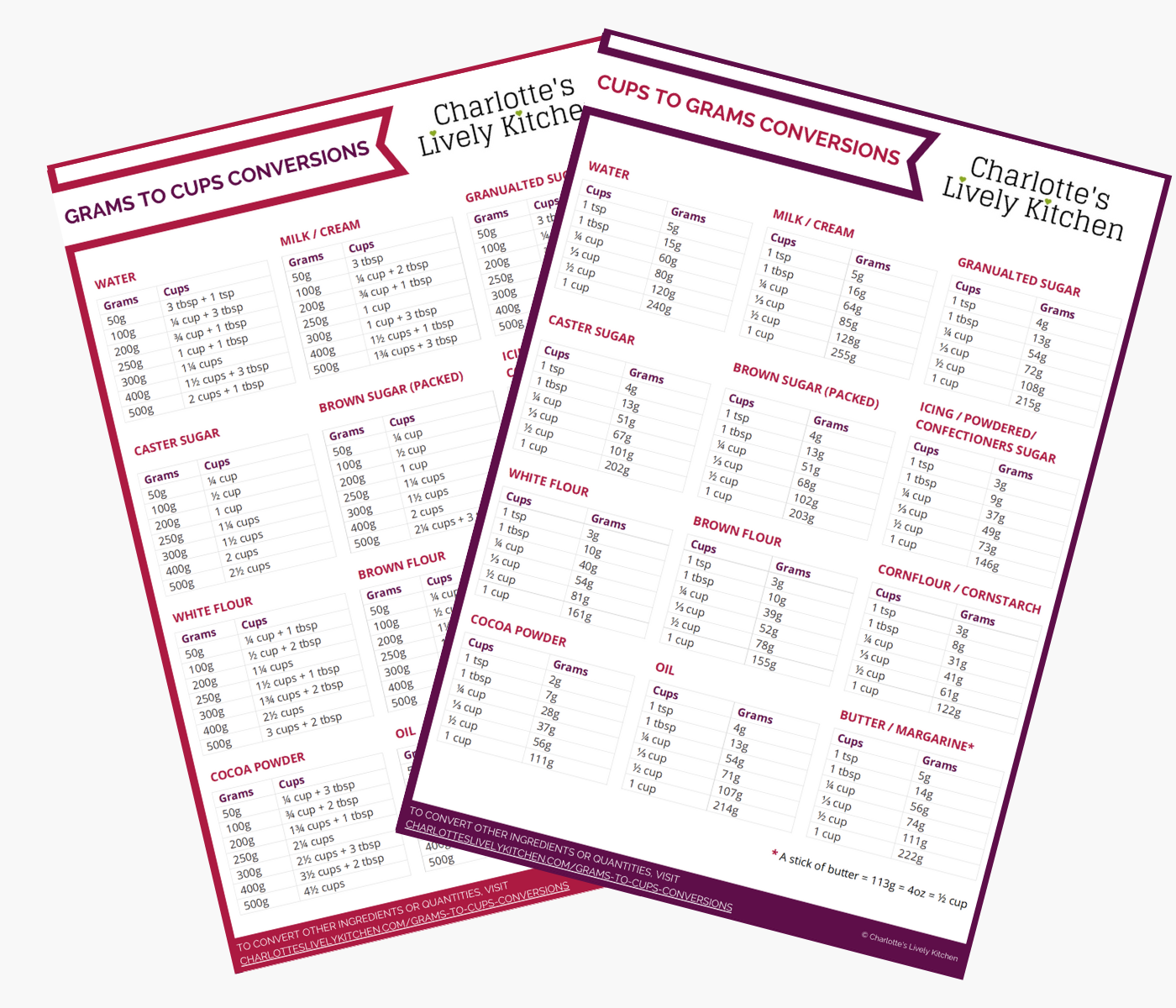
Subscribe to the Charlotte's Lively Kitchen mailing list to get your FREE printable grams to cups and cups to grams conversion charts for twelve popular baking ingredients
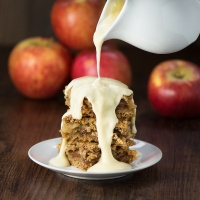
Homemade Custard
INGREDIENTS
- 300 ml full fat milk
- 4 egg yolks
- 30 g caster sugar
- 30 g plain flour
- ½ tsp vanilla extract
RECIPE VIDEO
INSTRUCTIONS
- Separate 4 eggs, putting the yolks into a large bowl.
- Add the caster sugar (30g) and whisk until combined.
- Add the plain flour (30g) and vanilla extract (½ tsp) and whisk until combined.
- Heat the full fat milk (300ml) on a very gentle heat until warmed but not quite boiling. Stir regularly to ensure that it does not burn.
- Once the milk is warm, remove from the heat and gradually add to the large bowl a bit at a time. Whisking each addition in completely before adding more.
- Once combined, put the mixture into the pan and return to a very gentle heat.
- Continue to cook, whisking constantly, until the custard has reached your desired thickness – this usually takes about 10 minutes but will depend on how runny you want your custard to be. You must whisk the custard constantly to avoid it going lumpy.
- Remove from the heat and continue to whisk for another minute.
- Serve.
If you’re making the custard to use later
- Put the custard into a bowl or jug and cover with cling film. It is important that the top of the custard is in full contact with the cling film to prevent a skin forming while the custard cools.
- Place into the fridge until you’re ready to use it.
- When you want to use the custard, reheat in a pan, stirring regularly to ensure that a skin doesn’t form. You’ll find that the custard will thicken further as it reheats. It it starts to become too thick, simply add a little more milk to get it to your desired consistency.
NOTES
NUTRITIONAL INFORMATION
Any nutritional information provided is the estimated nutritional information per serving. Please refer to my guide to Charlotte’s Lively Kitchen nutritional information if you would like to learn more about how this is calculated.
Free From/Suitable For…
The ingredients I used to make this recipe are all free from the following allergens. However, please check any labels carefully for allergens you need to avoid as brands can vary and product recipes can change over time.
- Suitable for Vegetarians
- Tree Nut-Free
- Peanut-Free
- Sesame-Free
- Soya-Free
- Sulphur Dioxide & Sulphite-Free
- Lupin-Free
This recipe can be made gluten-free by switching the plain flour for cornflour.
This recipe can be made dairy-free by switching this milk for a dairy-free alternative.
You might also like to try my delicious HOMEMADE CHOCOLATE CUSTARD or my festive BRANDY & ORANGE CUSTARD.
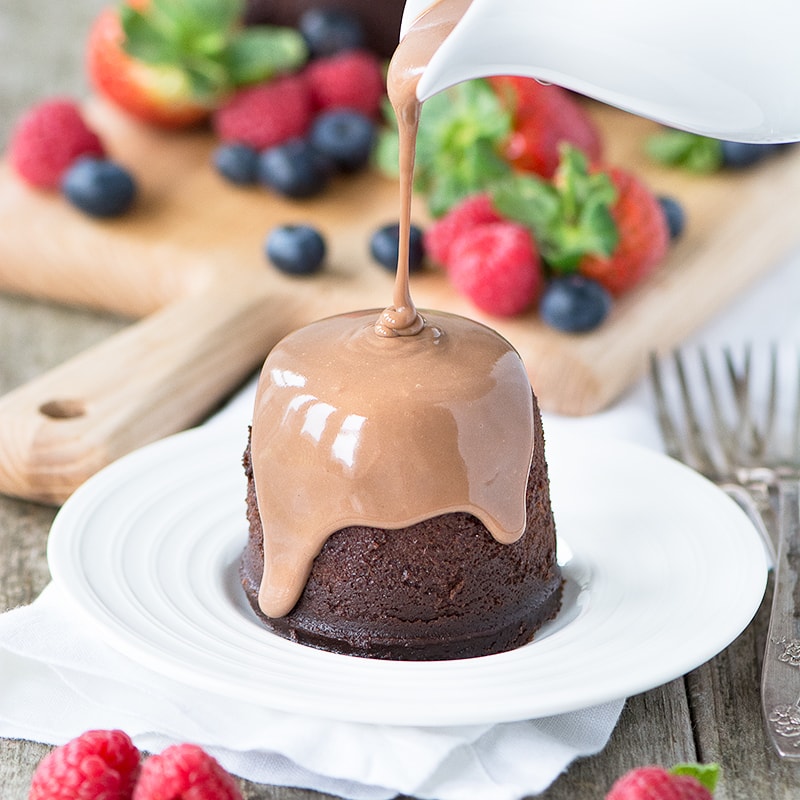
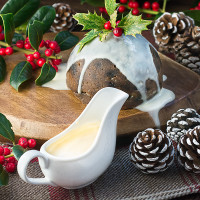
Homemade Custard FAQs
Over time I’ve been asked quite a few questions about this recipe. To save you needing to scroll though the comments to see what’s been asked before here are the answers to the most common questions…
Can you make custard using cornflour?
Yes. I’ve chosen to use plain flour in this recipe as I find that more people have it in the cupboard than cornflour, but cornflour will also work just fine. If you’d prefer to use cornflour then simply substitute 2 tbsp of flour for 2 tbsp of cornflour in the recipe.
Switching the flour to cornflour will also mean that this recipe is gluten-free, so perfect for anyone with an allergy or intolerance.
Can you make custard using self-raising flour?
Technically yes, but I wouldn’t recommend it. The consistency and appearance of the custard will be just like using plain flour of cornflour, but the raising agents in the self-raising flour have quite a strong flavour which just doesn’t taste good in custard.
Can you make custard using a dairy-free milk alternative?
Yes. I’ve not tried all of the types of milk but I know oat and almond milk work well. I suspect the others would work equally as well.
Can you make custard using granulated sugar instead of caster sugar?
Yes. The sugar dissolves into the custard as it’s heating so they work equally as well.
I added too much flour and now it tastes too floury. How can I fix it?
The easiest way to disguise the flavour of the flour if you added too much is to add more vanilla extract. If you find the extra flour has made it too thick, simply whisk in a little extra milk.
I kept my custard on the heat for too long and now it’s too thick. How can I fix it?
The easiest way to thin it out is to put it back onto a gentle heat and whisk in some more milk until it’s your desired consistency. If you add too much milk, simply keep it on the heat until it has thickened again.
If you find it’s gone a little lumpy then pass it through a sieve to remove any lumps and it’ll be just fine.
What are you pouring the custard onto in the first picture?
That’ll be my homemade apple crumble flapjacks. They’re a great match 😋
Pin this recipe for later
This post was originally published on 14th January 2015 and updated with new images and FAQs on 13th June 2018.


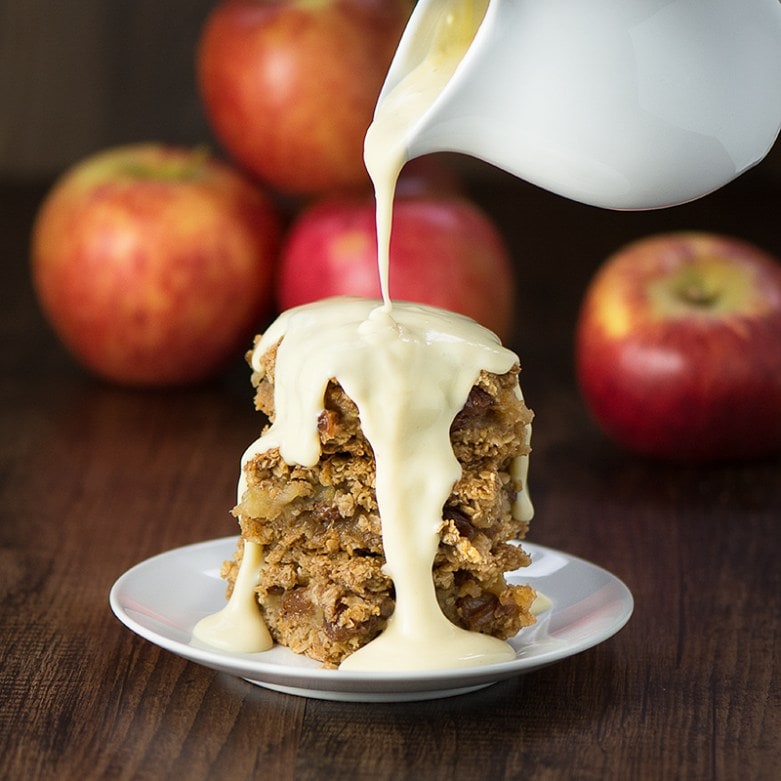
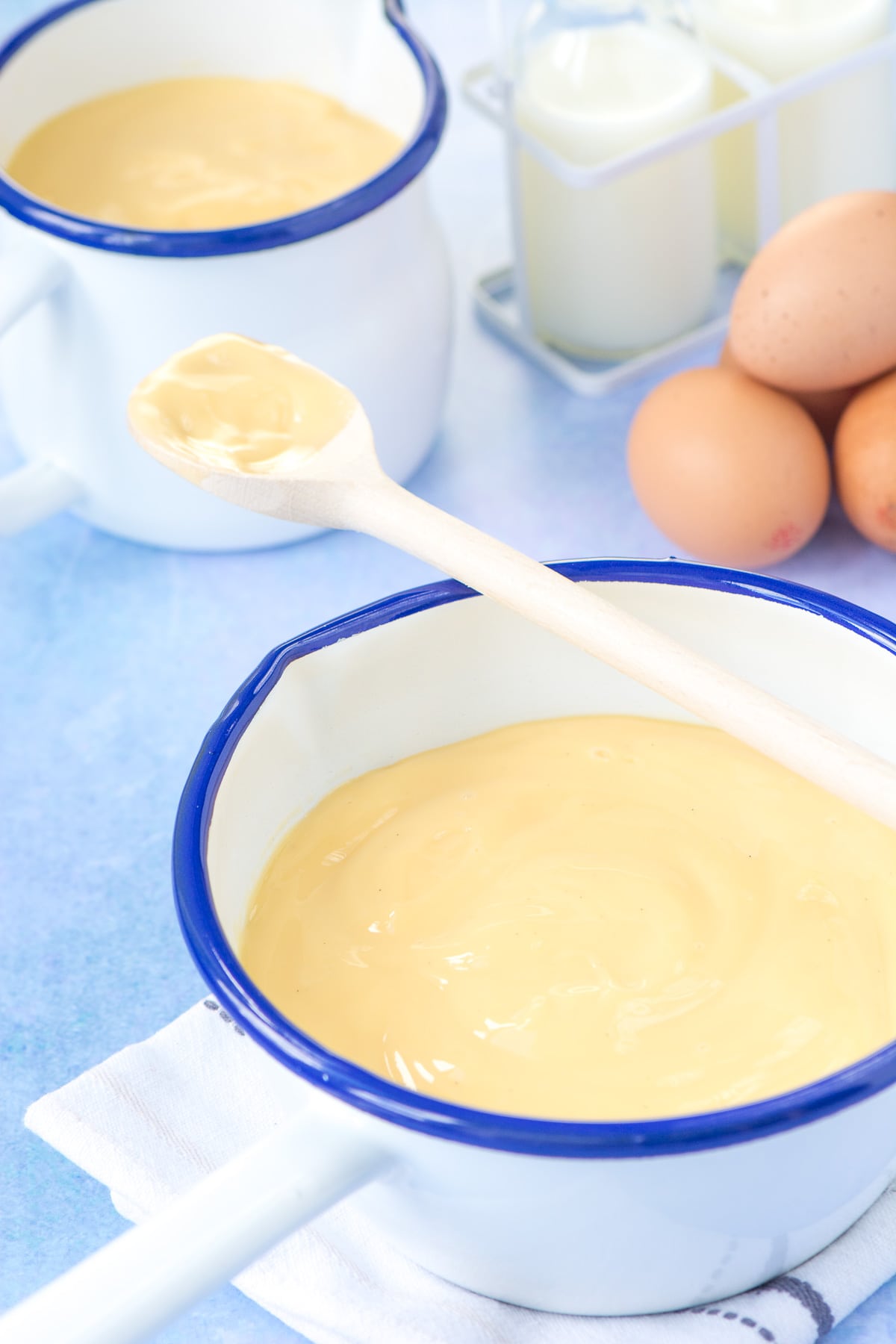

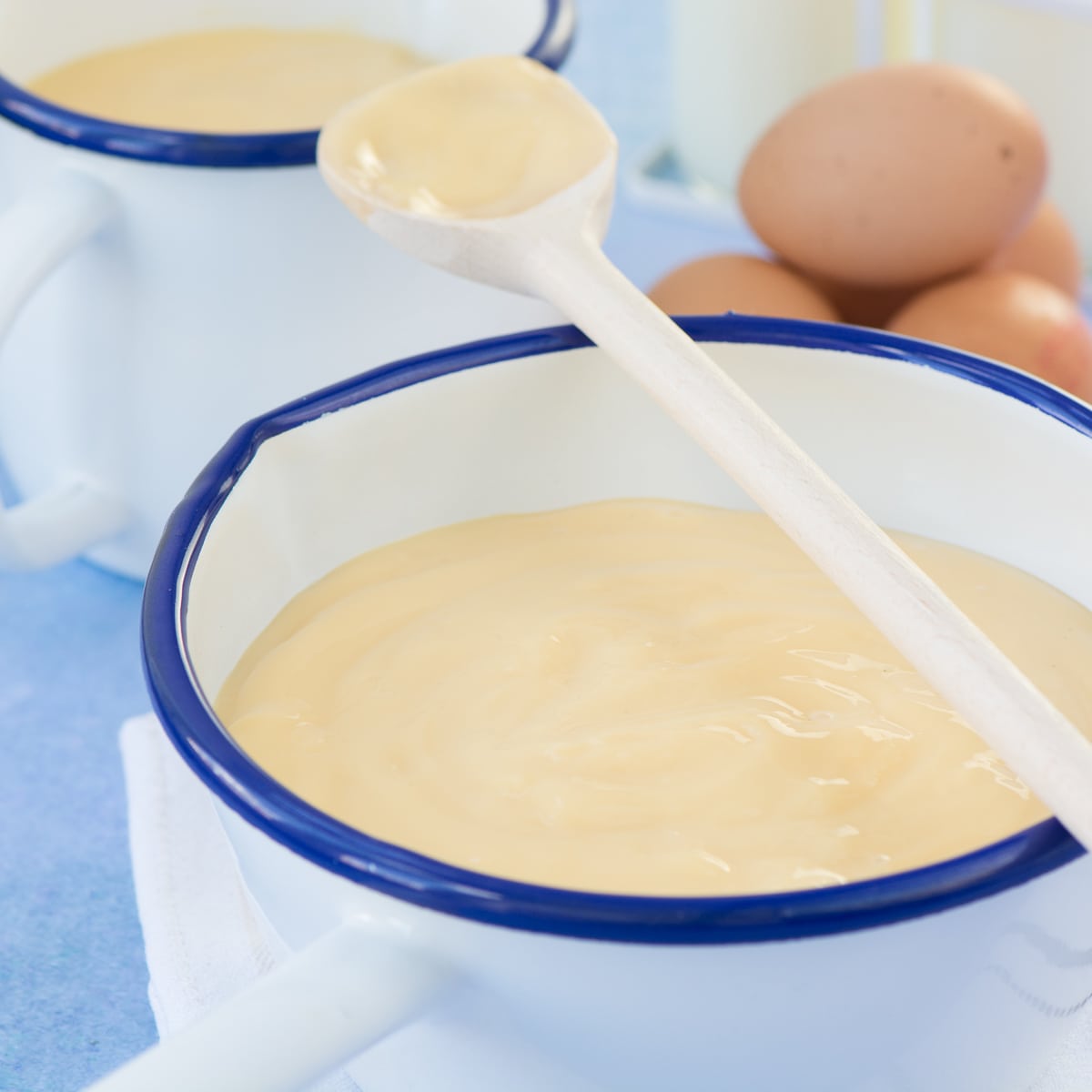

Lyleigh says
Do you use large eggs or medium?
Charlotte Oates says
I usually use whichever size I have lying around! You can read more about egg sizes in baking here – Eggs: Does Size Matter?
Rose says
Hi, have you a strawberry custard and a white sauce for cake recipes you can share please. I noticed chocolate and brandy orange so I’m very hopeful. thank you.
Charlotte Oates says
Unfortunately I don’t have a specific strawberry sauce recipe but I’ll bear this in mind for future recipe development.
Heidi says
Hi, I would like to understand the texture and consistency of traditional custard for instance when my grandmother made it the texture was smooth and creamy with the consistency of like Greek yogurt or French style Oui yogurt; am I describing a flan? Your custard seems to have more the consistency of a gravy and can pour over say and apple crisp or an British style pudding (suet pudding comes to mind)
Charlotte Oates says
For me traditional custard is definitely something you pour, but is thick like cream. The customer you describe can be made by continuing to thicken the custard for longer.
Roberta. says
I only use skimmed milk at home can I use this instead of whole milk.
Charlotte Oates says
You can and it’ll work fine, you’ll just have a slightly less rich flavour to your custard.
Soobee2 says
I made this recipe, it was delicious. Except, I only had semi skimmed milk, light brown sugar and cornflour! Also, I just weigh all ingredients into a saucepan over low heat and just kept whisking , adding extra milk for consistency!Just gorgeous stuff for apple pie. Thank you, how I managed it, I just do not know!!!!!!
Stella M says
Super recipe. Simple, straightforward and fuss free. Perfect measurements. Perfect taste. Thanks for sharing, much appreciated.
Lindsey says
I really like this recipe. I just made it and it is every bit as good as anything I ever bought at Tesco (at least). I didn’t have plain flour, only strong, so I reduced the amount to 25g. I also used a candy thermometer and let the temperature rise to 75°C to take the guesswork out of it. Really good, I shall be sharing this.
JUDE says
Sugar, I think I have just done myself out of getting away with tinned custard for ever. Used our last tin last night and needed a quick fix for the left over apple plait , voila and a success, nice one Charlotte, simple, cupboard staples and tasty too.
Louise Savage says
Made this again but with almond milk and it was delicious.
Louise Savage says
A delicious smooth custard and easy to make.
Mr Adam says
Really horrid custard, don’t bother with flour just use cornflour and half of stated quantity. Charlotte – get a grip and stop posting garbage.
Charlotte Oates says
I’m sorry to hear that you didn’t enjoy the custard. However, I think to describe a recipe that you can clearly see from the comments has been enjoyed by many other people as “garbage” is unfair. Whilst I love it when people enjoy my recipes, I know there will always be a subset of people who just don’t like them because we’re all different and have different tastes. If I had a recipe on here that no one enjoyed, I’d be straight back in the kitchen to figure out what was wrong, but that isn’t the case with this recipe and so I’m going to leave it as it is for all the people that enjoy the same style of custard I do. I hope you find the perfect recipe for you soon too.
Helen says
Harsh, no need to be disrespectful , all u had to say is i tried it but didnt like it
Chris says
As others have said, the recipe uses too much flour and not enough vanilla.
Lindsey says
Add the vanilla after thickening (at the end) and it will taste stronger
Sigita says
Absolutely the best custard recipe ever! I tried many, but with this one, others don’t stand a chance. Thank you so much!
Christine Hammond says
Delicious, I’m so happy I found this recipe, it was just what my peach and pear crumble needed.
Ledum Basil says
wow, thanks, i never knew it was that easy.
Ron says
Have you ever actually made this custard recipe? The amount of flour is way too much. It got thick in about 1 minute. Taste is OK but it needs more vanilla.
Nomangwe Zwane says
Such an amazing recipe. I made this the topping of a trifle and the custard was awesome.
Kerina Wallace says
I really didn’t like this recipe it had far too much of a floury taste and the next day it was inedible. I realise that everyone has different tastes but I’ll be sticking to the version made with cream In future.
Lynn says
This recipe was easy and the instructions were very clear, but to me it tasted too much of flour at the end (reminded me of paste). It also thickened after about 2 minutes of whisking at the end, so I added more milk a few times and kept cooking in case the flour taste might dissipate. I also tried to add more vanilla to offset the flour-y taste. (Btw, I didn’t use too much flour, I weighed everything as per the recipe) Next time, I will follow your technique but use cornflour instead.
Louise says
Perfect consistency and sweetness. Since I had no all purpose flour I used a little cornstarch and added some clotted cream.
The custard thickened up within 5 minutes of adding egg mixture to the warmed milk. This will be my go to recipe now!
Thank you .